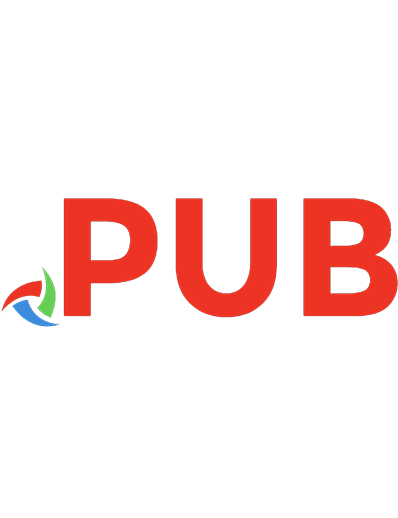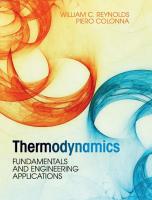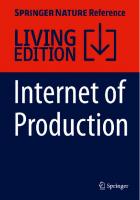Fundamentals and Applications of Colour Engineering 9781119827184, 9781119827207, 9781119827191, 9781119827214
FUNDAMENTALS AND APPLICATIONS OF COLOUR ENGINEERING EXPERT OVERVIEW OF THE WORLD OF COLOUR ENGINEERING IN THE 21ST CENT
175 19 24MB
English Pages 400 Year 2023
Table of contents :
Cover
Series Page
Title Page
Copyright Page
Table of Contents
Series Editor’s Foreword
Preface
Introductory Notes
1 Instruments and Methods for the Colour Measurements Required in Colour Engineering
1.1 Introduction
1.1.1 The Need for Colorimetry
1.1.2 The Principles of Colorimetry
1.1.3 Making the Transition from What We “See” to Quantifying How We “Match” a Colour
1.2 Visual Colorimetry
1.2.1 A Method to Uniquely Map the Colour of Lights and Objects
1.2.2 Development of the CIE Method of Visual Colorimetry
1.2.3 Applications of Visual Colorimetry
1.2.4 Disadvantages of Visual Colorimetry
1.3 Analogue Simulation of Visual Colorimetry
1.3.1 Replacing the Human Eye with an Optoelectronic Sensor
1.3.2 Substituting Coloured Filters to Approximate the CIE Colour-Matching Functions
1.3.3 Assessing the “Goodness of Fit” of a Set of Colorimeter Filters
1.3.4 Schematic Description of Analogue Filter Colorimeters
1.3.5 Disadvantages of Analogue Filter Colorimeters
1.4 Digital Simulation of Visual Colorimetry
1.4.1 Replacing the Analogue Filters with an Abridged Spectrometer
1.4.2 Assessing the “Goodness of Fit” of Abridged Spectrometers
1.4.3 Schematic Description of Digital Spectrocolorimeters
1.4.4 Advantages and Disadvantages of Digital Spectrocolorimeters
1.5 Selecting and Using Colorimeters and Spectrocolorimeters
1.5.1 Reading and Understanding Specifications and Technical Literature
1.5.2 Verifying Performance Specifications
1.5.3 Standards of Colour and Colour-difference
1.5.4 Sources of Error and Uncertainty in the Measurement of Reflectance, Transmittance and Radiance
1.6 Geometric Requirements for Colour Measurements
1.6.1 Colour Measurements from Self-Luminous Objects
1.6.2 Colour Measurements from Reflecting or Transmitting Objects
1.7 Conclusions and Expectations
1.7.1 Current CIE and ISO Activities in Colour and Colour-difference Measurements
1.7.2 Quality Management Systems and Colour Measurements
References
2 Colorimetry and Colour Difference
2.1 Introduction
2.2 Colorimetry
2.3 Normalization
2.4 Colour Matching Functions
2.5 Illuminants
2.6 Data for Observers and Illuminants
2.7 Range and Interval
2.8 Calculation of Chromaticity
2.9 Calculation of CIE 1976 Uniform Colour Spaces
2.10 Inversion of CIELAB Equations
2.11 Colour Difference
2.12 Problems with Using UCS Colour Difference
2.13 Uniformity of the Components of Colour Difference
2.13.1 Chroma
2.13.2 Hue
2.13.3 Lightness
2.14 Viewing Conditions
2.15 Surface Characteristics
2.16 Acceptability of Colour Differences
2.17 Overcoming the Limitations of UCS Colour Difference with Advanced Colour Difference Metrics
2.18 CIE94
2.19 CIEDE2000
2.20 Progress on Colour Difference Metrics since CIEDE2000
2.21 3D Colour Difference
2.22 Colour Difference in High Luminance Conditions
2.23 Colour Difference Formulas Based on Colour Appearance Models
2.24 Limitations in the Use of Advanced Colour Difference Metrics in Colour Imaging
2.25 Basis Conditions
2.25.1 Illuminant
2.25.2 Illuminance
2.25.3 Sample Separation
2.25.4 Sample Size and Image Structure
2.26 Colour Difference in Complex Images
2.27 Acceptability and Perceptibility
2.28 Large vs Small Differences
2.29 Deriving Colour Difference Tolerances
2.30 Sample Preparation
2.31 Psychophysical Experiments
2.31.1 Observer Variability and Experience
2.32 Colour Difference Judgements by Observers with a Colour Vision Deficiency
2.33 Calculating Colour Tolerances from Experimental Data
2.34 Calculation of Discrimination Ellipsoids and Tolerance Distributions
2.34.1 Calculation of Parametric Constants in Weightings Functions
2.35 Calculation of Acceptability Thresholds
2.36 Evaluating Colour Difference Metrics
2.37 Conclusion
References
3 Fundamentals of Device Characterization
3.1 Introduction
3.1.1 Objectives
3.2 Characterization Methods
3.2.1 Test Charts
3.2.2 Calibration
3.2.2.1 Matching Aim Values
3.2.2.2 Optimizing Performance
3.2.2.3 Perceptual Uniformity of Device Values
3.2.2.4 Optimization for Machine Vision
3.2.3 Linearization
3.3 Numerical Models
3.3.1 Regression Methods Used in Characterization
3.3.1.1 First Order Model
3.3.1.2 Higher Order Models
3.3.1.3 Choosing the Polynomial Order
3.3.1.4 Spline Methods
3.3.1.5 Weighted Regression
3.3.2 Domain
3.3.3 Optimization
3.3.4 Noisy and Discontinuous Data
3.3.5 Machine Learning
3.4 Look-Up Tables with Interpolation
3.4.1 Packing
3.4.2 Extraction
3.4.3 Interpolation
3.4.4 LUT Implementation
3.4.4.1 LUT implementation in ICC profiles
3.5 Evaluating Accuracy – Training and Test Data
References
4 Characterization of Input Devices
4.1 Input Channels
4.2 Characterization Goals
4.3 Transform Encoding
4.4 Dynamic Range
4.5 Input Characterization Methods
4.5.1 Scanners
4.6 Targets
4.7 Modelling
4.7.1 Digital Cameras
4.8 Target-Based Characterization
4.9 Targets
4.10 Modelling
4.10.1 Spectral Sensitivity-based Methods
4.10.2 Machine Learning Methods
4.10.3 Spectral Characterization of Input Devices
References
5 Color Processing for Digital Cameras
5.1 Introduction
5.2 Basics of a Camera Sensor
5.3 The Camera Pipeline
5.3.1 Defective Pixel Correction
5.3.2 Black-Level Correction and Normalization
5.3.3 Lens Shading Correction
5.3.4 Autofocus, Autoexposure, Auto White Balance
5.3.4.1 Autoexposure
5.3.4.2 Autofocus
5.3.5 White Balance and Auto White Balance
5.3.5.1 White Balance
5.3.5.2 Manual and Auto White Balance
5.3.6 Demosaicing
5.3.7 Noise Reduction
5.3.8 Color Space Transform to Device-Independent Color Space
5.3.9 Photo-Finishing/Rendering
5.3.9.1 General and Selective Color Manipulation
5.3.9.2 Global and Local Tone-Mapping
5.3.9.3 Sharpening/Noise and Grain
5.3.9.4 Image Resizing/Super-Resolution
5.3.10 Color Mapping to Final Image Encoding Color Space
5.3.11 Compression and Save to Storage
5.3.12 RAW Image Capture
5.4 Multi-Frame Processing
5.4.1 HDR Imaging
5.4.2 Low-Light/Night-Mode Imaging
5.5 Towards the Neural ISP
5.6 Concluding Remarks
Acknowledgment
References
6 Display Calibration
6.1 Introduction
6.2 From CRT to Contemporary Display Technologies
6.3 The Display Never Sleeps… Merging Television and Computer Display Standards
6.4 The Evolution of Display Calibration Capabilities
6.4.1 Gamut Mapping
6.4.2 Manual Calibration
6.4.3 One Dimensional Lookup
6.3.4 The Matrix Shaper Architecture
6.4.5 Single 3-Dimensional LUT
6.4.5.1 3DLUT Considerations
6.4.6 Hybrid Matrix Shaper Utilizing 3DLUT Followed by a 1DLUT
6.5 Measurement Set Requirements
6.5.1 Pattern Generation
6.5.2 How Many Measurements are Needed?
6.5.3 Methods to Mitigate Drift in Display Measurements
6.6 Calibration Validation Methodologies
6.6.1 Numerical Scales
6.6.2 Visual Evaluation Targets and Methods
6.7 Low Blue Light Developments
6.8 Conclusions
References
7 Characterizing Hard Copy Printers
7.1 Introduction
7.2 Properties of Hard Copy Printers
7.3 Substrates and Inks
7.3.1 Fluorescent Whitening Agents
7.3.2 Inks
7.4 Colour Gamut
7.5 Halftoning
7.6 Mechanical Printing Systems
7.7 Printing Conditions
7.8 Digital Systems
7.9 RGB Printers
7.10 Test Charts
7.11 Printer Models
7.12 Block Dye Model
7.13 Physical Models
7.13.1 Density
7.13.2 Dot Area Models
7.13.2.1 Murray-Davies
7.13.2.2 Yule-Nielsen
7.13.2.3 Clapper-Yule
7.13.2.4 Additivity Failure
7.13.3 Neugebauer
7.13.3.1 Modified and Extended Neugebauer Equations
7.13.3.2 N-Modified Neugebauer Equations
7.13.4 Vector-Corrected Neugebauer Equations
7.13.4.1 Cellular Extensions
7.13.4.2 Spectral Extensions
7.13.4.3 Evaluation of Different Forms of the Neugebauer Equations
7.13.5 Colorant Models
7.13.5.1 Masking Equations
7.13.6 Beer-Bouguer
7.13.7 Kubelka-Munk
7.13.8 Extensions
7.14 Numerical Models and Look-up Tables
7.14.1 Black Printer
7.14.1.1 Spectral Grey-Component Replacement
7.14.1.2 Black Generation Algorithm
7.15 Inverting the Model
7.16 Multi-Colour and Spot Colour Characterization
7.17 Spectral Characterization
7.18 White Ink
7.19 Reducing the Frequency of Characterization
7.20 Conclusions
References
8 Colour Encodings
8.1 Introduction
8.2 Colour Encoding Components
8.3 Colour Spaces
8.4 Device and Colour Space Encodings
8.5 Colorimetric Interpretation
8.6 Image State
8.7 Standard 3-Component Colour Space Encodings
8.8 Colour Gamut
8.8.1 Extended Colour Gamut
8.9 Precision and Range
8.9.1 High Dynamic Range
8.9.2 Negative Values
8.10 Luminance/Chrominance Encodings
8.11 Conversion to Colorimetry
8.12 Implementation Issues
8.13 File Formats
References
9 Colour Gamut Communication
9.1 Introduction
9.1.1 Device Colour Gamut and the Usable Colour Gamut
9.1.2 Colour Space
9.1.3 Factors Affecting Colour Gamut
9.1.4 Gamut of an Image
9.2 How to Describe Colour Gamuts
9.2.1 Convex Hull
9.2.2 Alpha-Shapes
9.2.3 The Segment Maxima Method
9.2.4 Gamut Based on a Printer Model
9.2.5 Gamulyt Method
9.2.6 The Mountain Range Method
9.2.7 Defining Gamut Boundaries with a Test Target
9.3 How to Obtain a Colour Gamut of a Printing System
9.4 How to Obtain a Colour Gamut of a Display
9.5 How to Calculate Gamut Volume
9.6 How to Analyse Colour Gamuts
9.6.1 Metrics for Comparing Colour Gamuts
9.6.2 Gamut Analysis of an N-Colour Printing Process
9.7 How to Visualize Colour Gamuts
9.7.1 Venn Diagram
9.7.2 Gamut Rings
9.8 How to Communicate Colour Gamuts
9.8.1 How to Encode a Colour Gamut Description
9.8.1.1 Encoding Based on CxF
9.8.1.2 Encoding Based on an ICC Profile
9.8.1.3 Encoding Based on Tab-Delimited Text Files
9.9 Summary
References
10 The ICC Colour Management Architecture
10.1 Origins of the ICC
10.2 Fundamentals of the ICC Architecture: The PCS, the ICC Profile, Transforms and the CMM
10.2.1 Range and Precision
10.2.2 Tags and Types
10.2.3 Media-Relative Colorimetry
10.2.4 Image State
10.2.5 Rendering Intents
10.2.6 Profile Classes
10.2.7 Features of ICC v4
10.2.8 Making Profiles
10.2.9 Embedding Profiles
10.2.10 CMMs
10.3 Other CMM Operations
10.3.1 Function Inversion
10.3.2 Black Point Compensation
10.3.3 Channel Preservation
10.3.4 Gamut Mapping
10.3.5 Copyright and Security
10.4 Workflows
10.5 Current Status of ICC.1
10.5.1 Limitations of ICC.1
10.6 ICC.2
10.6.1 PCS
10.6.2 Data Types
10.6.3 Multiprocess Elements
10.6.4 Calculator
10.6.5 Workflows
References
11 iccMAX Color Management – Philosophy, Overview, and Basics
11.1 Background and Philosophy Leading to iccMAX
11.2 Overview
11.2.1 Making Connections
11.2.2 Transform Connection and Application
11.2.3 Encoding Transforms
11.2.4 MultiProcessing Element Transforms
11.2.4.1 Matrix Elements
11.2.4.2 Curve Elements
11.2.4.3 Tint Array Elements
11.2.4.4 CLUT Elements
11.2.4.5 Tone Mapping Element
11.2.4.6 Calculator Element
11.2.4.7 Emissive Elements
11.2.4.8 Emission Observer Element
11.2.4.9 Reflectance CLUT Element
11.2.4.10 Reflectance Observer Element
11.2.4.11 CAM Elements
11.2.5 Profile Structure Generalization
11.3 Creating Transforms
11.4 Specification Subsets via ICSs
11.5 Domain Specific Examples
11.5.1 Photography
11.5.2 Packaging
11.5.3 Medical Imaging
11.5.4 Fine Art
11.5.5 Critical Color on Wide Gamut Displays
11.6 Getting Started with iccMAX (Where Color Engineering Comes to Play)
11.7 Conclusion
References
12 Sensor Adjustment
12.1 Introduction
12.2 Aims of Sensor Adjustment
12.3 Luminance Adjustment
12.4 Chromatic Adaptation
12.4.1 Chromatic Adaptation in Colour Management
12.4.2 Chromatic Adaptation in ICC.2
12.5 Material-Equivalent Adjustment
12.6 Local Adaptation
12.7 Incomplete Adaptation
References
13 Evaluating Colour Transforms
13.1 Introduction
13.2 Accuracy
13.2.1 Metamerism
13.2.2 Smoothness
13.2.3 Spatial Artefacts
13.2.4 Spectral Accuracy
13.2.5 Acceptability
13.2.6 Sources of Error in Colour Transforms
13.2.7 Procedures for Colorimetric Transform Evaluation
13.2.8 Media-Relative Colour Transforms
13.3 Cost
13.4 Subjective Preference
13.4.1 Test Data
13.4.2 Reporting Evaluation Results
13.4.2.1 Visualisation of Results
References
14 Appearance Beyond Colour: Gloss and Translucency Perception
14.1 Introduction
14.2 Gloss Perception
14.2.1 Perceptual Dimensions of Gloss
14.2.2 Image Cues and Partial Models
14.2.3 Factors Impacting Perceived Gloss
14.2.3.1 Shape
14.2.3.2 Illumination
14.2.3.3 Motion
14.2.3.4 Observer
14.2.4 Summary and Open Questions
14.3 Translucency Perception
14.3.1 Transparency and Translucency
14.3.2 Image Cues and Partial Models
14.3.3 Factors Impacting Perceived Translucency
14.3.4 Summary and Open Questions
14.4 Interaction among Appearance Attributes
14.4.1 Impact of Colour on Gloss and Translucency
14.4.2 Interaction between Gloss and Translucency
14.5 Impact on Colour Technologies
14.6 Conclusion
References
15 Colour Management of Material Appearance
15.1 Introduction
15.2 Material Appearance Modelling
15.2.1 Blinn‒Phong Model
15.2.2 Ward Model
15.2.3 Cook‒Torrance Model
15.3 Appearance Support in Colour Management
15.4 A Colour Management Workflow for Material Appearance
15.5 Conclusion
References
16 Color on the Web
16.1 Early History
16.2 Color on the Legacy Web
16.2.1 RGB Representations
16.2.2 Color Names
16.2.3 Color with Alpha
16.2.4 Hue-Wheel Systems
16.2.5 Gradients
16.3 Wide Color Gamut (WCG) Comes to the Web
16.3.1 The Importance of Display P3
16.3.2 WCG Raster Images, with ICC Profiles
16.3.3 Development of WCG Upgrades to Web Specifications
16.3.4 Limitations of CIELAB: Introducing OK Lab
16.4 Color on the Wide Gamut Web
16.4.1 Predefined RGB Color Spaces
16.4.2 Device-independent Color Spaces
16.4.3 WCG Gradients
16.4.4 Manipulating and Mixing Colors
16.5 HDR Comes to the Web
16.5.1 Introducing HDR
16.5.2 HDR in Canvas
16.5.3 HDR in WebGL and WebGPU
16.5.4 HDR in CSS
References
17 High Dynamic Range Imaging
17.1 Introduction and Background
17.1.1 The Human Visual System
17.1.2 Color Imaging
17.2 High Dynamic Range Imaging
17.2.1 HDR Acquisition
17.2.1.1 Single Exposure HDR Acquisition
17.2.1.2 Multi-Exposure HDR Acquisition
17.2.1.3 HDR Image Synthesis
17.2.2 HDR Image Storage
17.2.2.1 HDR Image Formats and Encoding
17.2.3 HDR Rendering
17.2.3.1 Tone Mapping
17.2.3.2 Reverse Tone Mapping
17.3 Conclusion
References
18 HDR and Wide Color Gamut Display Technologies and Considerations
18.1 Introduction
18.2 Early HDR Display Systems
18.3 Transmissive Displays
18.3.1 Liquid Crystal Display Technology
18.3.2 Global Modulation
18.3.3 Dual Modulation
18.3.4 Dual LCD Displays
18.4 Emissive Displays
18.4.1 Organic Light Emitting Diodes
18.4.2 Direct LED Displays
18.5 Projection Systems
18.5.1 Projection-LCD Dual Modulation
18.5.2 Screen Projection
18.6 Reflective Displays
18.7 Achieving Wide Color Gamuts
18.7.1 Designing Narrow Primaries
18.7.2 Multi Spectral or Multi-Primary Displays
18.7.3 Metameric Error
18.8 Spatial Display Properties
18.9 Temporal Display Properties
18.10 Signaling
18.10.1 Signal, Display and Content Properties
18.10.2 Signal Reference vs. Display Preference Modes
18.10.3 Professional vs. Consumer Displays
18.11 Characterization and Calibration
18.12 Ambient Effects
18.13 Conclusion
References
19 Colour in AR and VR
19.1 Introduction
19.2 Colour Synthesis in AR and VR Displays
19.2.1 GOG Display Model
19.2.2 Idealized Display Models
19.2.3 Spatial and Temporal Independence
19.2.4 HMD Optics
19.2.5 Measuring AR and VR Displays
19.2.6 Example: Measuring and Characterizing an AR Display
19.3 Colour Appearance in AR and VR
19.3.1 Limitations of CAMs for AR and VR
19.3.2 Chromatic Adaptation
19.3.2.1 Chromatic Adaptation in VR
19.3.2.2 Chromatic Adaptation in AR
19.3.3 Scission and Transparency in AR
19.3.3.1 Experimental Evidence for Scission in OST-AR
19.3.3.2 Interpretation of Transparency and Related Visual Effects
19.3.4 Example: Modelling an OST-AR Display and Colour Matching Results
19.4 Colour Imaging and Graphics in AR and VR
19.4.1 Colour Reproduction
19.4.2 Virtual Colour Reproduction
19.5 Conclusion
19.5.1 Open Questions in AR and VR
Acknowledgements
References
20 Colour Engineering Toolbox and Other Open Source Tools
20.1 Colour Engineering Toolbox 2.0
20.1.1 Colorimetry
20.2 Polar Calculations
20.3 Media-Relative and PCS Scaling
20.3.1 Adaptation
20.3.2 Difference
20.3.3 Characterization
20.3.4 Gamut
20.3.5 Utility Functions
20.3.6 Psychophysics
20.3.7 Documentation
20.3.8 Licensing and Use
20.4 DemoIccMax
20.5 Color.js
20.6 Little CMS
20.7 Argyll
20.8 Colour
References
Index
End User License Agreement



![Engineering Chemistry: Fundamentals and Applications [2 ed.]
1108724442, 9781108724449](https://dokumen.pub/img/200x200/engineering-chemistry-fundamentals-and-applications-2nbsped-1108724442-9781108724449.jpg)






